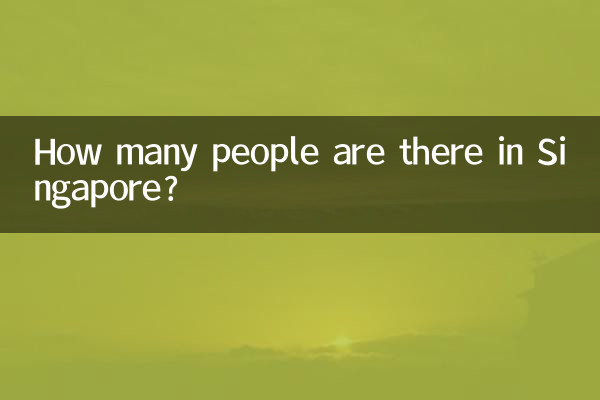How many people are there in Singapore? The latest population data and trend analysis in 2024
As an important global financial center and international metropolis, Singapore's demographic structure and changing trends have always attracted much attention. This article will provide you with a detailed analysis of Singapore's current population size, composition and future development trends based on recent hot data and topics.
1. Overview of Singapore’s latest population data

| index | 2023 data | Year-on-year change |
|---|---|---|
| total population | 5,917,600 people | +1.3% |
| citizen population | 3,570,600 people | +0.9% |
| Permanent Resident (PR) | 521,300 people | +3.7% |
| non-resident population | 1,825,700 people | +6.6% |
| population density | 8,358 people/km² | +1.5% |
2. Analysis of population structure characteristics
1.age structure: Singapore is facing a significant aging trend. The proportion of the population aged 65 and above has reached 19.1%, while the population under the age of 15 only accounts for 12.9%.
| age group | population | Proportion of total population |
|---|---|---|
| 0-14 years old | 763,400 people | 12.9% |
| 15-64 years old | 4,038,900 people | 68.3% |
| 65 years and above | 1,115,300 people | 18.8% |
2.Racial composition: Singapore maintains the characteristics of a multi-racial society, with Chinese accounting for 74.3%, Malays accounting for 13.5%, Indians accounting for 9.0%, and other races accounting for 3.2%.
3.fertility rate: The total fertility rate (TFR) in 2023 is 1.04, which is far lower than the population replacement level of 2.1. This data has triggered extensive discussions on population sustainability from all walks of life.
3. Recent hot topics in population
1.Immigration policy adjustments: The Singaporean government recently announced that it will moderately relax its skilled immigration policy to deal with labor shortages and aging issues.
2.housing policy reform: As the population grows, the supply and price of HDB flats have become hot topics, and the government has introduced new measures to protect citizens’ housing needs.
3.Pressure on medical resources: The increase in the elderly population has put pressure on the medical system, and there has been an increase in discussions about improving the efficiency of medical resource allocation.
4.work-life balance: In the context of low fertility rates, how to improve the workplace environment to encourage fertility has become a social focus.
4. Future population development trends
According to the Singapore Bureau of Statistics, Singapore's population may reach about 6.4 million by 2030. The main growth points will come from skilled immigrants and some foreign workers, while the natural growth rate of the native population is expected to remain at a low level.
| years | Projected total population | Prediction of the proportion of people aged 65+ |
|---|---|---|
| 2025 | 6,100,000 | 21.5% |
| 2030 | 6,400,000 | 24.0% |
| 2035 | 6,600,000 | 26.8% |
5. Summary
Singapore currently has a total population of approximately 5.91 million and is facing the dual challenges of increasing aging and low fertility rates. The government responds to changes in demographic structure by adjusting immigration policies and improving the social security system. Over the next decade, Singapore's population growth will focus more on quality than quantity to keep the city sustainable.
Understanding Singapore's population status not only helps to grasp the socio-economic trends of this city-state, but also provides an important reference for those who intend to work, invest or live in Singapore.

check the details

check the details